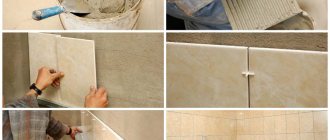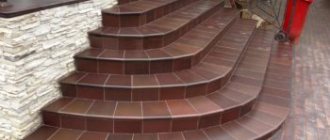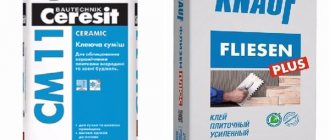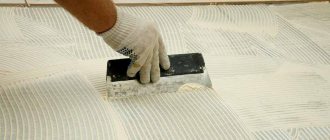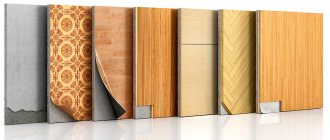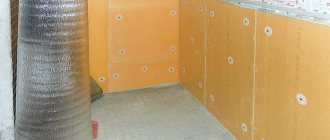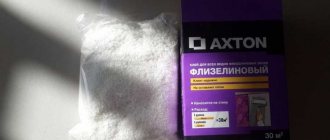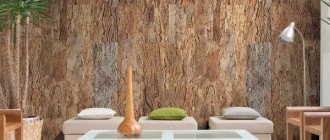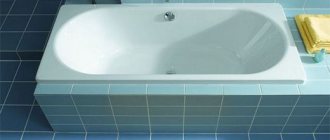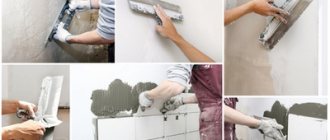Tile adhesives for underfloor heating are available in a wide range on the market, so choosing one can be a challenge. First of all, you need to understand the composition of the funds and the differences between them. After which it is advisable to study the existing rating of manufacturers and select the products that are most suitable in terms of parameters.
When selecting, it is important to take into account not only gender characteristics, but also experience in carrying out a similar procedure . In order for the tile installation to be used for many years, the master must strictly follow the instructions and rules indicated on the packaging and described in this article .
Let's get acquainted with the types of glue
In most cases, it is quite difficult for the buyer to choose the appropriate adhesive, especially if he does not have experience in repair work on laying heated floors. As a rule, formulations are classified according to the main active ingredient. They are of the following types:
- a polymer synthetic type with one main component - resin. The glue comes in the form of a paste, which is sold in a plastic bucket. It is most suitable if the master performing the procedure does not have relevant previous experience, because... Hardening occurs within 20-25 minutes after application. This time allows you to eliminate minimal errors and get rid of surface irregularities;
- polymer - with two different resins. Such a two-component product hardens very quickly, so it should be used immediately after preparation, when all the preparatory steps have already been completed. An important advantage is increased ductility and adhesiveness, which leads to resistance to sudden changes in temperature and the possibility of operation even when laying the material on a complex base;
- cement mortar consisting of fine particles. Despite the large selection of polymer products, this option remains the most popular. Due to the presence of additional modifying substances, the adhesion of the product increases. The key advantage is the ability to calculate the exact dosage of the product so that it is enough for exactly one use, this will allow you to use 1 package several times.
The main element that imparts heat resistance is a plasticizer, which is used as an additive. These substances allow the glue to expand and contract with changes in temperature without losing its adhesive properties.
It is difficult to choose the best adhesive for floors; each of the above types has its own characteristics, advantages and disadvantages.
It is important to know! It is worth noting that when selecting tile adhesive for heated floors, the weight of the facing material is not a priority parameter, as, for example, when selecting adhesive for walls. There are some other characteristics that you need to be aware of.
What parameters do we pay attention to when choosing
Special requirements are imposed on the adhesive composition for porcelain tiles on heated floors due to difficult operating conditions. Before purchasing, you need to familiarize yourself with important parameters:
- resistance to temperature changes. As a rule, adhesive for underfloor heating and porcelain tiles themselves have different expansion coefficients. This parameter assumes that as the temperature decreases or increases, the adhesive mass will contract and expand. With low stability, microcracks will form on the adhesive surface, which will ultimately lead to separation and damage to the tile cladding. It is important to choose a mixture with high elasticity, but even then it will be necessary to additionally ensure a strong connection in the areas of the damping joints.
- The degree of adhesion of the glue to the surface. In most cases, cement types cannot provide sufficient adhesion to tiles, so it is advisable to choose polymer types or cement ones, but with the addition of a large amount of plasticizers. They allow you to increase adhesion with smooth artificial stone.
- Strength. As noted earlier, the weight of the tiles is not as important as when laying tiles on walls (due to the force of gravity), but it is still worth considering, especially if choosing adhesive for porcelain tiles. Before purchasing, make sure that the adhesive composition can withstand increased and multidirectional loads. Otherwise, it will disintegrate within the first year of operation.
- Time until completely hardened. It is necessary to select an option whose adjustment time is up to 2 hours, and the possible period of position correction is at least 15 minutes. This will allow you to avoid ineffective waste of expensive material, especially if you are working with such a complex coating as porcelain stoneware. This will also ensure the correct placement of the tile cladding, which will improve the quality of the repair work.
Which tile adhesive is best for heated floors? The one that has the highest values in all of the above parameters.
Types of glue based on basic composition
The adhesives of different brands contain different base components. This breaks the masses into varieties:
- Ready-made one-component adhesive mixture. It is convenient to use as it has a paste-like consistency. Such masses contain resins of artificial origin, acrylic additives, and modifiers. This variety does not set quickly; there is time for adjustment (up to 20 minutes).
- Quick-setting adhesive with two-component structure. The solution is prepared only before application. The base is epoxy resin with polyurethane components. Such masses are resistant to temperature changes, have high adhesion and flexibility. Suitable for complex substrates.
- Cement masses. The base is Portland cement with fine-grained river sand. Plasticizers are used as additives. This variety is considered universal. It is convenient to use, since you can prepare the required amount of solution.
By structure
- Mastic is a paste-like adhesive mixture in finished form. Recommended for use in finishing new buildings.
- Dry mixture - diluted with water before use. The dry mixture is considered the most reliable and durable.
By composition of ingredients
- Epoxy adhesive is noted for its high strength and reliability, resistance to temperature changes and high humidity, but it is quite expensive.
- Dispersive - not suitable for ceramic tiles, but widely used for fixing drywall, plastic, wood and metal.
- Cement - affordable, provides excellent adhesion to concrete and brick, and is quite waterproof.
When choosing a suitable solution, you must take into account the fact where it will be used: bathroom, living space or outdoors. Based on this parameter, it is worth selecting glue taking into account its components.
Types by packaging method
Currently, the following types of tile adhesive for underfloor heating are most commonly used:
- Dry mixtures consisting of high quality cement, to which the necessary modifiers have been added. Supplied to retail chains in bags. Before use, mix with water in the required proportions.
- Ready-made mixtures . They are made on the basis of various epoxy resins and PU (polyurethane). Supplied to retail chains in hermetically sealed buckets. Can be used immediately.
Don't miss: Warm floors in the kitchen under tiles: features, advantages and disadvantages, installation, photos
Tile adhesive in bags
The suitability of the adhesive in buckets for tiling heated floors is determined by special markings, which must be applied and inform about the suitability of the adhesive for such use. Typically these are notes like:
- elastic;
- for heated floors;
- for warm floors.
Ready-made tile adhesive in buckets
Manufacturers rating
Today there are quite a lot of manufacturers of tile floor adhesive on the market: Ceresit, Bergauf, etc. They differ not only in composition and method of application, but also in the scope of operation.
Some types are only suitable for certain underfloor heating and floor tiles, while others have a wide range of applications.
Ceresit
Ceresit glue for heated floors is the most popular imported option. It is manufactured in Germany, but has become widely known among Russian consumers. It has increased elasticity, so it can be used for various types of heated floors and finishing materials.
Ceresite is optimal for porcelain stoneware and ceramic tiles (choose SM models No. 14, 16, 17 or 117). Tile adhesive for marble (CM 115) is also popular.
The advantage of Ceresit for underfloor heating is of the highest German quality, which ensures the possibility of operation for many years.
Another advantage is that it is manufactured exclusively from safe and environmentally friendly components. The produced tile mixture does not harm the environment and health, and also does not emit hazardous substances even with a strong increase in temperature.
However, it is important to strictly follow the instructions on the packaging and in the accompanying instructions. If it is indicated that the mixture is suitable only for concrete, it cannot be used for other surfaces (wood, plastic, metal).
What you need to know about tile floor adhesive CM 14 Extra:
- survivability – 2 hours (time before hardening);
- The master can adjust the placement of tiles within 15 minutes. after initial application;
- when carrying out repair work, the air temperature should be 5-30 degrees Celsius;
- Grouting of seams is allowed no earlier than one day after installation;
- degree of adhesiveness – 0.8 MPa;
- The coating created with Ceresit glue for heated floors can be used at temperatures from -30 to +70 degrees.
Bergauf
This Russian-German brand produces Keramik Express glue. Its distinctive advantage is that the mixture dries quickly; you can walk on the tiles within 4 hours after finishing laying.
This reduces the waiting time before grouting, but also reduces the time required to correct the position of the material. Recommended for craftsmen who already have experience in the relevant work.
What you should know about this tile adhesive for heated floors:
- survivability of the diluted mixture – 45 minutes;
- a one-time covering should be no more than 0.6-0.8 m2;
- changing the position of the material is allowed only for 10 minutes;
- It is allowed to rub damper joints after 4 hours;
- The temperature during operation should be from -10 to +70 degrees.
This tile mixture is the best option for installation on a solid base that is not subject to deformation (for example, concrete).
Knauf
Floor adhesives of this brand are available in a wide range, but for heated floors you will need a special mixture - Knauf Flex. This tile adhesive is excellent for laying on a complex base (gypsum fiber coating or old tiles).
The characteristics are among the best: high elasticity and adhesion (1 MPa), excellent waterproofing.
The prepared solution can be used for 3 hours, correction time is 10 minutes. The permissible temperature during installation is 5-25 degrees, and during operation -30 to +80. Grouting of the resulting joints is allowed only 3 days after installation work.
What is important to know:
- Before laying the tiles, the warm floor must warm up completely at least once, and then cool down for a day;
- If the air temperature in the room when installing tiles on a warm floor is below 10 degrees, you need to turn on the heating to 15 degrees;
- Before placing electric heating mats, it is necessary to prime the base with a special mixture of the same brand;
- If the room humidity is high, the surface must be coated with Knauf Flachendicht.
Litokol
This manufacturer produces a domestic cement mixture for heated floors (model K80). The dry mixture is prepared before starting work. Tile adhesive for heated floors has the following properties:
- Vitality – 20 minutes;
- The adjustment period is 1 hour, which is one of the highest values compared to analogues;
- Room temperature during installation is 5-40 degrees;
- Operation is allowed in a temperature range of -30 to +90 degrees;
- Grouting of seams is possible within a day.
If it was decided to use polymer tile adhesive for the floor, then this manufacturer offers the Litoelastic adhesive mixture. It must be used within 45 minutes after mixing, another 45 minutes are allocated for possible position adjustments.
Unis
The tile adhesive “Yunis” is domestically produced, but the quality is not inferior to the European Ceresit. Most products on sale are universal and suitable for any coating.
The advantage of this tile mixture is that it is completely environmentally safe, which allows it to be used even for finishing heated floors in a child’s room. Another advantage is increased adhesion (1.2 MPa).
Features of Eunice adhesive for heated floors:
- viability of the finished adhesive solution – 180 minutes;
- the period before the applied composition dries on the tile is 20 minutes;
- period of possible correction – 10 minutes;
- grouting of damper joints – every other day;
- Operation is possible at temperatures from -50 to +70 degrees.
There is no need to use such glue for a deformed base.
Prospectors
A Russian manufacturer produces tile adhesive “Starateli Plus”, which is intended for installing the material on the floor. It can only be used on surfaces that are not prone to deformation.
The prepared composition can be used within 4 hours after the solution, and only 15 minutes will be allocated to correct the position of the tile. The adhesion value is 0.5 MPa, this is sufficient for most types of tile coverings.
Founds
The Russian brand Osnovit produces “Maxiplix T-16” specifically for heated floors. It has an increased pot life (4 hours). Correction time – 15 minutes. Optimal for simple coatings (for example, cement screed).
Choosing the best tile adhesive
To make the right choice of tile adhesive for porcelain tiles on a heated floor, it is necessary to take into account the characteristics of the room (the ability to provide the required temperature during installation and operation), the complexity of the floor covering (concrete screed is the simplest, and old tiles or gypsum fiber surfaces are the most labor-intensive) and the type of heating system floors
Ceresite is well suited for water floors; it can be used even by beginners in laying flooring. For electrical structures, it is recommended to choose Knauf (if an additional screed is not created) or Bergauf (if you plan to create a screed).
If you need to choose a budget option, then you should study Russian brands. For example, “Starateli” glue has increased elasticity and, at the same time, a relatively low cost.
Types of heated floors
Today in private houses, apartments and offices you can find the following types of floor heating systems:
- cable;
- water;
- infrared (film);
- thermostatic, i.e. heated mats.
The most affordable and at the same time simplest option is to install an electric heated floor in tile adhesive.
Let's take a closer look at the installation rules.
Installation instructions
To work you will need to prepare the following tools:
- Construction spatula with teeth;
- Adhesive (suitable for underfloor heating systems);
- Ladle, trowel, brush;
- Deep priming agent (it must be compatible with the selected tile adhesive for underfloor heating);
- Mixer;
- A container of suitable volume for preparing tile adhesive;
- Level;
- Tile cutter;
- Facing material;
- Rubber hammer.
Stages of laying tiles on a warm water floor using glue (using the example of a concrete screed without deformation):
- Removing dust and other debris from the screed (it is best to vacuum it).
- Surface primer to improve adhesion. The mixture should be applied exclusively to dry screed. To check this, you need to cover a certain area with film overnight; if drops appear on it in the morning, you need to additionally dry the floor. The primer should completely cover the surface without the slightest gap.
- Preparation of the adhesive solution. It should be made strictly according to the instructions. Mix all ingredients with a mixer and add water at the end.
- Preparing the tiles. To increase adhesion, priming the inside of the future coating is allowed.
- Apply underfloor heating adhesive to the screed; use a spatula to level the layer. It is not necessary to cover a large area at once; it is better to spread the mixture gradually.
- Apply the mixture to the tiles (the thickness should be minimal - up to 0.5 cm).
- Lay the tiles, keeping equal gaps between them, using plastic crosses (they can be removed after 2 hours).
- When the tile adhesive for heated floors has completely dried, grout the joints.
The process of laying a warm coating under the tiles
Depending on the thickness of your floor covering, it is better to choose one or another type of warm electric floor. If the thickness is not too large, then we recommend choosing heating mats or infrared film for installation. Below we will talk about the features of laying both types of coatings.
How to lay a heated floor consisting of heating mats
What are heating mats? These are fiberglass reinforced meshes, to which a screened section is attached, with the following characteristics:
- the maximum thickness of the mats is 3 mm;
- the presence of technology for connecting the hot and cold parts of the floor without couplings, which ensures maximum reliability of the structure;
- meshes allow penetration of screed material or tile adhesive.
- Laying with mats has the following features:
- before the installation process, draw up a special diagram indicating the placement of all furniture and other items in the room;
- After you have chosen a place to place the thermostat, you need to equip a junction box there, make grooves in the wall and the base of the floor for the connection wires and temperature sensor.
The rough coating must be very well cleaned of dirt, dust and unnecessary things. To ensure a reliable bond between the special adhesive and the tiles, prime it.
The sensor should be installed inside a pre-prepared channel, which is installed as follows:
- calculate its depth so that it does not interfere with laying the tiles;
- place the channel at the same distance from the cable turns;
- the channel must not intersect with the heating cable or be in close proximity to it.
If necessary, thanks to the channel it will be possible to quickly change the heated floor sensor.
When you have completed all the preliminary work, you can begin laying the structure itself. Thermal insulation measures are not necessary in this case, since installation of thermal insulation can lead to the cable overheating and failure.
Laying consists of several stages. To begin with, the mat needs to be rolled out according to a specially prepared pattern along the entire floor area using the “snake” method. To do this, when rolling out, it may be necessary to cut the fiberglass mesh
This should be done very carefully and carefully, trying not to damage the cable:
- make a turn and cut the mesh crosswise;
- Unroll the mat with each laying cycle from one wall to the next. When turning, you must maintain a minimum distance between turns of 6 cm;
- Obstacles that arise must be avoided so that the distance to the cable is about 5 cm;
- remove the mesh partially if you cannot get around the obstacle. A free cable is placed along it;
- if the room has an unusual shape, then the mesh can be removed and the cables can be laid in any shape. It is not recommended to bend it too much, but do not forget to maintain a distance of at least 6 cm between the turns.
And to connect it to the thermostat you need about 4 power wires, and when there are not enough cold ends, you need to cut the heating cable out of the mat without removing the coupling from the screed.
The final installation stage looks like this:
- after you have cut and stretched the mat, you need to roll it up again in the cut form into a roll, open the protective strip of adhesive tape on the underside, and then roll it out again over the entire surface of the floor;
- cover the entire covering with a special tile adhesive with a layer of up to 7 cm. When it dries, you can lay the tiles;
- when the heating mat is laid, connect the wires to electricity, this turns on the thermostat, sensor and safety shutdown device.
Features of laying an electric floor with infrared film
The infrared film that floors of this type are equipped with is an extremely thin insulating film up to 1 mm, in which electrically conductive material is placed inside.
The preparatory measures are practically no different from the option of laying the floor on heating mats. However, you must not forget to lay the thermal insulation materials, but only lay the infrared film itself on top in parallel sheets; you cannot lay them overlapping. Next, you should install the thermostat and check the system for functionality.
Now we attach the mounting mesh so that the screws cannot damage the contacts, and then we fill the mesh with a screed made of cement and sand. Test the system again for functionality.
Wait for the screed to dry and lay the tiles using a special adhesive that has heat-resistant properties.
You can turn on the infrared heated floor almost a month after installation, when the tile adhesive is sure to dry.
Features of application
When laying a warm electric or water floor, beginners quite often make certain mistakes:
- Incorrect installation in the areas of damper joints (here, in most cases, the tiles come off). It is necessary to apply glue on top and elastic sealant on the bottom.
- Use universal glue for any surfaces. It is better to give preference to a highly specialized option; its adhesion is significantly higher than that of universal products.
- Before purchasing tiles for heated floors, make sure there are no defects. If they are discovered after purchase, take this into account when choosing a layout. Also, shortcomings can be compensated for by an increased thickness of the tile adhesive layer.
- Installation of tiles using slightly dried adhesive. In such a case, the ceramic tiles will come off quite quickly; it is better to renew the adhesive layer.
- Walk on the tile until the specified period has passed until it has completely hardened. If a person accidentally steps on the floor covering, you need to carefully remove the slipped tile, replace it and the adhesive layer.
The choice of tile adhesive for underfloor heating must take into account many factors, especially the type of existing subfloor, the type of tile and the type of heating system.
It is also necessary to rely on the relevant experience of the specialist if the procedure is performed independently. If you have no experience, it is better to choose products with a long adjustment and viability time.
What thickness of glue should be
The thickness of the adhesive layer when laying heated floors is calculated based on the recommendations of the manufacturer of the electrical cable or mats. It is usually recommended to maintain a minimum thickness of 3-5 mm. A layer of half a centimeter can be made using a special comb with a tooth height of 1 cm.
When laying mats, for the best result, it is better to apply a minimal layer of tile adhesive directly to the mesh with the cable. Afterwards, when laying tiles, use a 0.8-10 mm comb.
Thanks to precise installation technology, it is possible to calculate the adhesive consumption per m². Calculations are made as follows:
- Tile sizes. According to the technology, the thickness of the adhesive solution for laying traditional 30*30 cm floor tiles will be from 3.5 to 4.5 mm. A tile with a side of 60 cm requires a layer of 5 mm. Additionally, you will need to apply the solution to the back side of the porcelain stoneware. As a result, the optimal adhesive layer for large slabs will be about 6 -7 mm.
- Spatula dimensions. The most commonly used comb is with a pitch of 8, 10, 12 mm. The packaging indicates the solution consumption per 1 m². So, for a spatula with a tooth of 10 mm per m², you will need to use 4.2 kg of glue. It turns out that the glue consumption rates will be approximately 1 bag (25 kg) per 5-6 m² of tile.
Heat-resistant adhesive used for underfloor heating has good insulating properties. Therefore, the thicker the layer, the worse the floor covering will warm up. The optimal distance between the cable and the tile is 3-5 mm.
What grout to use for heated floors
Grout for heated floors and tile adhesive must be from the same manufacturer. The general rule is to select products designed specifically for cladding over heating cables or mats.
Each glue manufacturer has a separate line of grout for joints. The color of the fugue practically does not matter and is selected based on the overall tone of the tile. It is recommended to seal the joints between wall and floor tiles with silicone compounds to avoid cracking.
The thermal conductivity of tile adhesive creates optimal conditions for uniform heating of the ceramic coating laid on top of heated floors. It is prohibited to use conventional cement-sand mortars for cladding!
